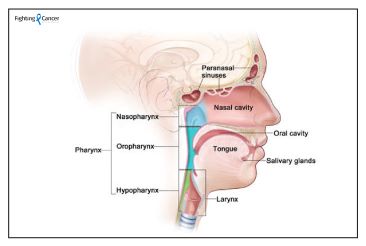
Head and neck cancers are more common in individuals over 40 years of age. Men are at a higher risk of developing head and neck cancer due to their higher rates of smoking and drinking.
Head and neck cancer can occur in different parts of the head or neck, including the mouth, throat, nasal cavity, sinuses, salivary glands, and lymph nodes. There are several risk factors associated with head and neck cancer-
- Tobacco: It may refer to smoking, cigarettes, cigars, pipes, or chewing tobacco. It is the leading risk factor for head and neck cancer and accounts for almost 70% to 80% of cases.
- Alcohol: Frequent, heavy, and long-term alcohol consumption leads to mouth and throat cancer.
- Marijuana use: People who smoke marijuana are at a higher risk of head and neck cancer. The vapor of marijuana affects the upper respiratory tract.
- Betel Quid and Gutka: Many people in Asia chew betel quid or gutka, which increases the risk of head and neck cancer.
- Gender: It is more common in men than women.
- Age: People over 40 years tend to develop head and neck cancer.
- Diet: A diet with high salt food increases the risk of nasopharyngeal cancer. Inadequate intake of fruits and vegetables is also considered a risk factor for head and neck cancer.
- Ancestry: These cancers are more common in Asian ethnic groups.
- Prolonged sun exposure: People who are exposed to sunlight for a long time are at a high risk of developing skin cancer of the head and neck.
- Exposure to radiation: It may lead to salivary gland cancer.
- Human papillomavirus (HPV): There is a strong link between human papillomavirus and head and neck cancer. Unsafe sexual activities increase the risk of getting affected by this virus.
- Epstein-Barr virus (EBV): This virus causes glandular fever and leads to nasopharyngeal cancer.
- Poor oral and dental hygiene: The risk is high for people with poor oral hygiene. Teeth missing, bleeding gums, and gum diseases increase the risk. Dentures that do not fit properly are also at risk of developing head and neck cancer.
- Environmental and occupational inhalants: Inhalation of certain environmental and occupational chemicals such as asbestos, wood dust, and paint fumes increases the risk of developing head and neck cancer.
- Gastroesophageal reflux disease (GERD) and laryngopharyngeal reflux disease (LPRD): These can lead to the development of head and neck cancer.
- Weakened immune system: When our immunity weakens, it increases the risk of developing fatal diseases like cancer.
- Previous history of head and neck cancer: If anyone has a previous history of head and neck cancer, they are at a higher risk of developing this cancer once again in their life.
- Genetic Syndrome: Genetic syndromes like Fanconi anemia and dyskeratosis congenital may increase the risk of developing head and neck cancer.
Make an effort to lead a healthy lifestyle to prevent cancer.
References:
https://www.cancer.net/cancer-types/head-and-neck-cancer/risk-factors-and-prevention
https://www.mskcc.org/cancer-care/types/head-neck/risk-prevention-screening
https://www.macmillan.org.uk/cancer-information-and-support/head-and-neck-cancer/causes-and-risk-factors-of-head-and-neck-cancer
https://www.cancercouncil.com.au/head-and-neck-cancer/risk-factors-for-head-and-neck-cancers/
https://www.cancercenter.com/cancer-types/head-and-neck-cancer/risk-factors
Image Source:
https://www.cancer.gov/

